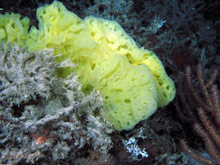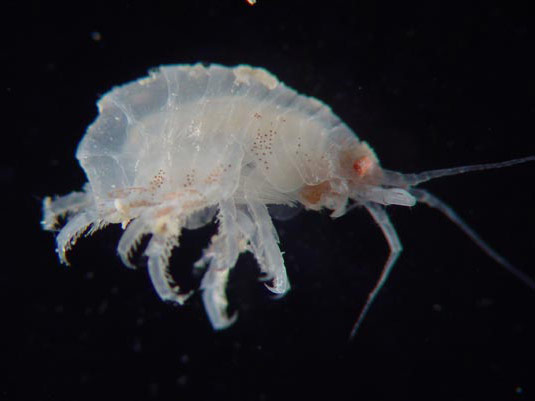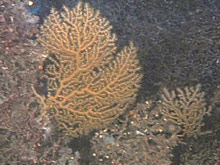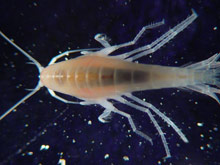
Figure 1: A hexactinellid sponge. Small juvenile amphipods enter the sponge and become "captive" as they grow too large to escape from inside the sponge's chambers. Click image for larger view and image credit.
All New Species Are Not The Same
November 13, 2005
James Thomas, Ph.D.
Professor; Fulbright Scholar,
AAAS Science Fellow
Invertebrate Biology/Biological Oceanography
Nova Oceanographic Center
Organisms that live in close associations with one another where neither organism is harmed are referred to as commensal. In the marine realm, commensal species have evolved highly characteristic and unusual morphologies (appearances) as a consequence of their way of life. My specialty is a group of crustaceans called amphipods that are abundant and ecologically important in all marine habitats. Amphipods are generally small (2-10 mm; rarely 50mm).
Several families of amphipods are known to inhabit the internal cavities of sessile (attached to the ocean bottom) invertebrates such as sponges, tunicates, and bivalves. Once thought to be rare, commensal amphipods are now being documented as scientists look more closely for these associations. It requires little extra effort to wash deep coral samples for commensals and the advent of research submersibles has opened a door to further investigate the occurrence and evolution of commensal associations.

Figure 2: A new species of commensal amphipod collected from Paramuricea coral. The brown spots may be used to mimic the coral's polyps. Click image for larger view and image credit.
Prior to this cruise, my research focused on tropical taxonomy and ecology of amphipods. As scientists begin to investigate deep water coral habitats, the opportunity to document associations with the corals and sponges provides an unparalleled opportunity to investigate commensal associations of deep water corals and sponges. I joined this expedition with the hopes of documenting some new amphipod host/commensal associations. Prior to the first dive I asked the scientists to be on the lookout for the glass-like hexactinellid sponges (Figure 1) that may house commensal amphipods. When the submersible surfaced I saw a large yellow glass sponge in the biobox that looked very "amphipod worthy'. Upon careful dissection in the lab (sharp silicate "needles" called glass spicules inside the body of the sponge are sharp and possibly toxic) I began to see bright white amphipods that had become "trapped" in the sponge. Rushing quickly to use an unoccupied microscope, I observed a nearly blind amphipod with features and characteristics never before known in the group (view the new species of a commensal amphipod). This particular new species was taken from blind chambers, meaning that the amphipod had entered the sponge through the sponge's sieve plate openings as a small juvenile. Therefore the larger adults are "captive" inside the sponge and would remain there until their death.
Subsequent dives have provided even more new species of commensal amphipods from sponges and soft corals. A rinse of Golden sea fan corals (Paramuricea) have revealed large numbers of another undescribed species of amphipod whose light orange color is an exact match for the coral tissue (Figures 2 and 3).
This cruise has been a success, providing at least three new species,
and, possibly, a new family of amphipods. (view
a close-up of the bamboo coral Keratoisis flexibilis | ![]() see
the Bioluminescing Bamboo Coral). These scientific cruises are additive
in that knowledge is incrementally gained and passed to a broader scientific
community. Now that these associations have been documented, other scientists
will know to look at collected specimens for commensals. The deep sea is
a new frontier full of excitement and opportunity. For me, this expedition
has provided access to the deep sea via submersible collections. To see
this environment first hand is a thrill that I am glad to have had, and
will now want to repeat!
see
the Bioluminescing Bamboo Coral). These scientific cruises are additive
in that knowledge is incrementally gained and passed to a broader scientific
community. Now that these associations have been documented, other scientists
will know to look at collected specimens for commensals. The deep sea is
a new frontier full of excitement and opportunity. For me, this expedition
has provided access to the deep sea via submersible collections. To see
this environment first hand is a thrill that I am glad to have had, and
will now want to repeat!
Sign up for the Ocean Explorer E-mail Update List.


























